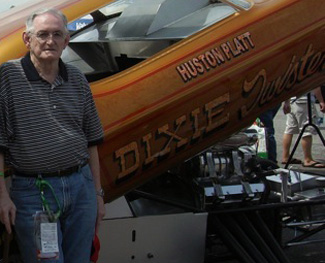
Georgia's Huston Platt poses with his Funny Car, the restored Dixie Twister. Photo courtesy Racin' Today.com
By Rick Minter-Guest Contributor
Posted in Columns 12/9/11
The phone call on Wednesday, Nov. 30 from Rocky Platt brought sad news. His father Huston Platt, the pioneering drag racer, had died at his Buford, Ga., home. He was 79 years old.
I’d heard of Huston Platt for years, but never actually talked to him until a few years ago, when Rocky invited me to their home to see the “Dixie Twister”, Platt’s old Funny Car that had been tracked down in Nova Scotia and restored by one of his former crew members, Randall Davis.
My main worry that afternoon was how to write a story about Huston Platt and the Dixie Twister and not dwell on the tragedy that occurred March 2, 1969, at Yellow River Dragstrip in Covington, Ga.
On that day, Platt was in the Twister racing Frank Oglesby on a narrow, sandy track. Fans crowded to within a few feet of the track to get a better view of the cars.
Witnesses said one of those fans reached onto the track to retrieve a beer can just as Platt deployed his parachute to slow his car. The opened parachute swept up the man, killing him instantly.
The weight of the victim against the parachute yanked Platt’s car into the spectator area. Twelve people died, and more than 40 more were injured. It remains the worst racing disaster on U.S. soil. Yellow River, one of Georgia’s most popular tracks, never held another race.
Investigators determined that unsafe track conditions were to blame. Racing, as it has done throughout history, had outrun the safety measures of the day. But the incident led to sweeping safety reforms in all types of motorsports. New legislation required tracks to carry insurance, and the insurance companies helped ensure the safety of fans and competitors. Even NASCAR founder Bill France found himself testifying before legislators on behalf of the racing community.
In the years afterward, the Platts were understandably leery of the media, and with good reason given some of the stories written about Yellow River.
But that day turned out to be one I’ll always treasure, and I came to greatly respect Huston Platt.
He seemed to know that to do a credible story about him and his car, I had to deal with the Yellow River issue. He talked openly and honestly about it. But in his eyes, you could see the pain he still carried from that incident.
He never said: “Why me?” but I kept thinking to myself: “Why him?”
He did point out that the race cars had outrun the race tracks of the day.
“It was going to happen,” Platt said quietly the afternoon I interviewed him. “It was just a matter of when and where. There wasn’t a track in 10 states that was qualified to run those cars back then.
“It was a bad thing, but it led to safe racing, if you can say it’s safe.”
Since the Yellow River track, which never held another race and is now the main road of a mobile home park, was near Platt’s hometown, he lived the rest of his life in the same general area as the victims and their survivors. In many ways, he could never get away from the tragedy, even after he gave up racing.
“I’ve got feelings just like everybody else,” he said. “When I gave it up, I didn’t want to talk about it. The only time racing ever came up, it was always about Yellow River. I just shut it out completely. …
“I got my mind on other things, worked, played golf. I didn’t even think about racing or watch it on TV until a few years ago.”
But seeing the Dixie Twister, which wasn’t seriously damaged in the Yellow River crash, back in full racing trim seemed to lift a great weight off Platt’s shoulders.
When he accompanied the Twister to public events, the conversations with fans almost always were about the happy times, times when was racing all over the country, outrunning the top drag racers of the day and even winning match races against NASCAR stars like Richard Petty.
“I beat ‘em all,” Platt said as he and I looked over scrapbooks from his racing days on the day I first met him.
I prefer to remember that aspect of Platt’s career. I hope others will too.
Editor’s note: This story was originally published at Racin’ Today.com on December 2, 2011.
Rick Minter is an award-winning sports journalist who began covering motorsports for the The Atlanta Journal-Constitution in 1991, as well as serving as a bureau chief. Minter focused on racing exclusively from 2000-2008 . Minter and his wife Joanne live on the family farm in Inman, Georgia. In his spare time he collects and restores antique tractors and trucks.
Questions, comments, suggestions? Email us!
This website is not affiliated with or endorsed by the Georgia Racing Hall of Fame or the Georgia Auto Racing Hall of Fame Association, Inc. All content is the intellectual property of the individual authors. All opinions are those of the individual authors. Please do not repost images or text without permission.
